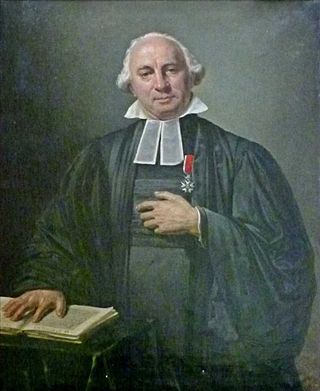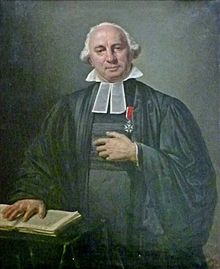
Athanase Laurent Charles Coquerel was a French Protestant theologian, born in Paris, elected deputy of the Constituent Assembly after the revolution of February 1848.

The Scots Kirk Paris is a Presbyterian Protestant church situated in Paris, in rue Bayard near the Champs-Elysées in the 8th arrondissement. It is the only congregation of the Church of Scotland in France, part of the International Presbytery.

The American Church in Paris was the first American church established outside the United States. It traces its roots back to 1814, and the present church building - located at 65 Quai d'Orsay in the 7th arrondissement of Paris, France - dates to 1931.

The Church of Saint-Germain l'Auxerrois is a medieval Roman Catholic church in the 1st arrondissement of Paris, directly across from the Louvre Palace. It was named for Saint Germanus of Auxerre, a medieval bishop of Auxerre, who became a papal envoy and met Saint Genevieve, the patron saint of Paris, on his journeys. Genevieve is reputed to have converted Queen Clotilde and her husband, French king Clovis I to Christianity at the tomb of Saint Germain in Auxerre.

St Thomas' Church is a historic building in Strasbourg, eastern France. It is the main Lutheran church of the city since its cathedral became Catholic again after the annexation of the town by France in 1681. It is nicknamed the "Protestant Cathedral" or the Old Lady, and the only example of a hall church in the Alsace region. The building is located on the Route Romane d'Alsace. It is classified as a Monument historique by the French Ministry of Culture since 1862. Its congregation forms part of the Protestant Church of Augsburg Confession of Alsace and Lorraine.

The Diocese of Moulins is a Latin diocese of the Catholic Church in France. The episcopal see is located in the city of Moulins. The diocese comprises all of the department of Allier in the region of Auvergne.

The Diocese of Montauban is a Latin Church diocese of the Catholic Church in France. The diocese is coextensive with Tarn-et-Garonne, and is currently a suffragan of the Archdiocese of Toulouse. The episcopal seat of the Diocese of Montauban is in Montauban Cathedral.

Protestantism in France has existed in its various forms, starting with Calvinism and Lutheranism since the Protestant Reformation. John Calvin was a Frenchman, as were numerous other Protestant Reformers including William Farel, Pierre Viret and Theodore Beza, who was Calvin's successor in Geneva. Peter Waldo was a merchant from Lyon, who founded a pre-Protestant group, the Waldensians. Martin Bucer was born a German in Alsace, which historically belonged to the Holy Roman Empire, but now belongs to France.

The Church of Saint-Roch is a 17th–18th-century French Baroque and classical style church in Paris, dedicated to Saint Roch. It is located at 284 rue Saint-Honoré, in the 1st arrondissement. The current church was built between 1653 and 1740.

Jean-Guillaume Moitte was a French sculptor.

The Temple du Marais, sometimes known as the Temple Sainte-Marie, or historically, as the Church of Sainte Marie de la Visitation, is a Protestant church located in the 4th arrondissement of Paris, in the district of Le Marais at 17 Rue Saint-Antoine. It was originally built as a Roman Catholic convent by the Order of the Visitation of Holy Mary, whose sisters were commonly called the Visitandines. The church was closed in the French Revolution and later given to a Protestant congregation which continues its ministry to the present. The closest métro station is Bastille

Pentemont Abbey is a set of 18th and 19th-century buildings at the corner of Rue de Grenelle and Rue de Bellechasse in the 7th arrondissement of Paris. The complex had originally been a Cistercian nunnery. The abbey was founded near Beauvais in 1217 and moved to its current site in Paris in 1672 at the behest of King Louis XIV. A reconstruction of the abbey was initiated in 1745 by the Abbess Marie-Catherine Béthisy de Mézières and work was completed in 1783. In the late 18th century, the abbey was one of the most prestigious educational institutions in Paris for daughters of the elite, including two of Thomas Jefferson's. The abbey also provided rooms for ladies of good standing who were in search of rest, including Joséphine de Beauharnais when the case of her separation from her first husband was heard.

Saint-Thomas-d'Aquin is a Roman Catholic church located in the 7th arrondissement of Paris, place Saint-Thomas-d’Aquin, between the rue du Bac and the boulevard Saint-Germain. The church is named for Saint Thomas Aquinas, a Dominican friar and priest, and influential philosopher and theologian in the 13th century. It was originally a chapel of an abbey of the Dominican order in Paris. Construction began in 1682, and the church was consecrated in 1682. The friars were expelled and the church was closed during the French Revolution, and was not returned to the Catholic church until 1802. During the 19th century, the City of Paris endowed the church with many fine examples of French religious art. The church was declared an Historic Monument in 1982.

Paul-Henri Marron was the first Reformed pastor in Paris following the French Revolution. Born in the Netherlands to a Huguenot family, Marron first came to Paris as the chaplain of the Dutch embassy. Protestants in France had been prohibited from worshipping openly since the Revocation of the Edict of Nantes in 1685. The Edict of Tolerance in 1787 gave non-Catholics the right to openly practice their religion. Marron was recruited to lead the newly tolerated Protestant community of Paris, a task he accomplished through the French Revolution, several imprisonments, the Napoleonic Wars, the Bourbon Restoration and into the July Monarchy.

The Église réformée de l'Oratoire du Louvre, is an historic Protestant church located at 145 rue Saint-Honoré – 160 rue de Rivoli in the 1st arrondissement of Paris, across the street from the Louvre. It was founded as a Catholic church in 1611, became the royal chapel of France and under Louis XIII, and then became a Protestant Church under Napoleon I in 1811. It is now a member of the United Protestant Church of France.
Protestantism was generally proscribed in France between 1685 and 1787. During that period Roman Catholicism was the state religion. The French Revolution began a process of dechristianisation that lasted from 1792 until the Concordat of 1801, an agreement between the French state and the Papacy. The French general and statesman responsible for the concordat, Napoleon Bonaparte, had a generally favourable attitude towards Protestants, and the concordat did not make Catholicism the state religion again.

Jacques Antoine Rabaut known as Rabaut-Pommier,, was a politician of the French revolutionary era. He was a member of the National Convention (1792–95) and of the Council of Ancients (1795–1801). In 1816 he was exiled for regicide under the Bourbon Restoration, though he later benefited from an amnesty. Deeply committed to medicine, he was an ardent advocate of vaccination.

Saints-Pères Cemetery is a historic cemetery in the 7th arrondissement of Paris, sited at what is now 30 rue des Saints-Pères.

The Saint-Germain Cemetery or Saint-Pierre Cemetery was a rectangular cemetery in Paris, first attested in 1259 and used by Protestants from 1598 to 1604 onwards. It was sited in the north-west corner of the former rue Taranne and rue des Saints-Pères, alongside the chapelle des Saint-Pères (on the site now occupied by square de la Charité at 186 boulevard Saint-Germain. It measured 27 toise by 8 toise. Its site is now covered by Square Taras-Chevtchenko.

French sculpture has been an original and influential component of world art since the Middle Ages. The first known French sculptures date to the Upper Paleolithic age. French sculpture originally copied ancient Roman models, then found its own original form in the decoration of Gothic architecture. French sculptors produced important works of Baroque sculpture for the decoration of the Palace of Versailles. In the 19th century, the sculptors Auguste Rodin and Edgar Degas created a more personal and non-realistic style, which led the way to modernism in the 20th century, and the sculpture of Pablo Picasso, Georges Braque, Marcel Duchamp and Jean Arp.


























